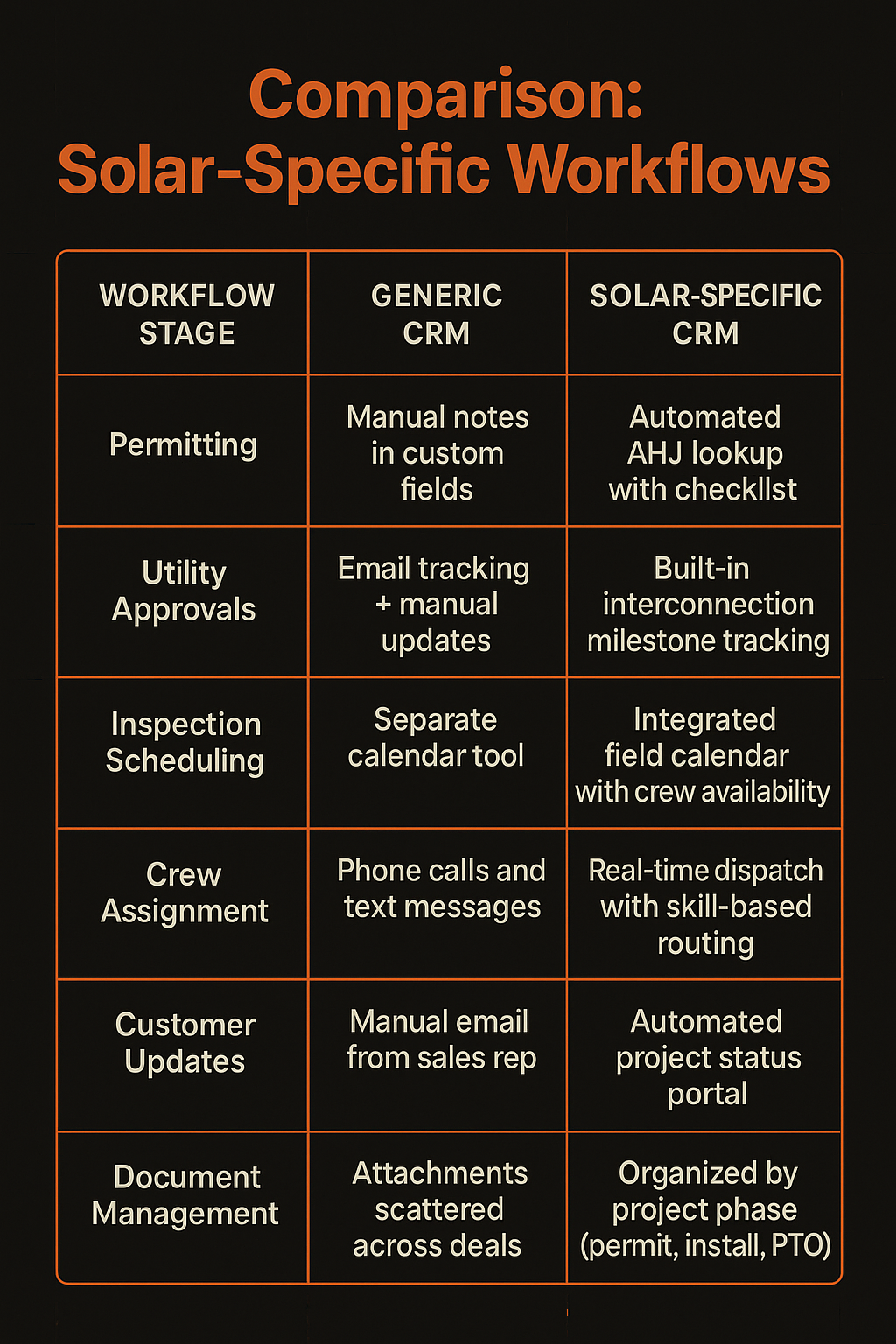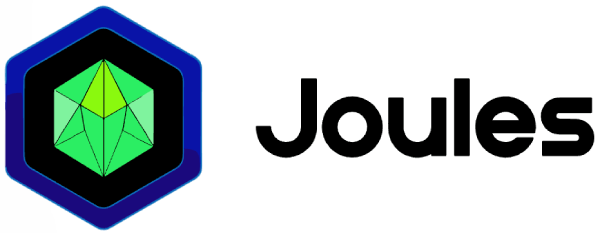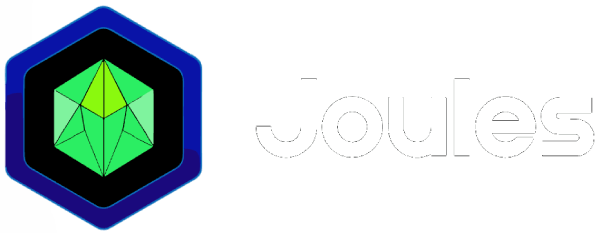Solar CRM vs. Generic CRM: The $50K Hidden Tax on Solar Installers
PUBLISHED 2025-10-16
Written by
JoulesCRM Team
Content Creator
Reviewed by
Editorial Team
Content Reviewer
Solar CRM vs. Generic CRM: The $50K Hidden Tax on Solar Installers
Your Salesforce subscription says $150 per month. Your HubSpot dashboard shows $120 per user. Clean, simple pricing, right?
Not quite.
The actual cost? Somewhere between $3,000 and $5,000 per month once you factor in what it really takes to make a generic CRM work for solar installation operations.
If you're a solar business owner evaluating CRM options—or silently frustrated with your current system—you've likely felt this tension. The sales pitch promises "flexibility" and "enterprise-grade power." But six months in, you're paying developers to build custom workflows, buying third-party integrations to track permits, and watching your field crews text each other because the CRM doesn't talk to your scheduling system.
This article will help you calculate the true total cost of ownership for generic CRMs versus purpose-built CRM for solar installers. We'll examine five hidden costs that add up to $40,000-$60,000 annually for the average solar installation company—and show you the solar-specific alternative that eliminates most of these expenses.
By the end, you'll have a framework to calculate your own hidden costs and make an informed decision about your CRM investment.
The True Cost of "Flexible" CRMs
Let's start with a reality check.
When you visit Salesforce or HubSpot's pricing page, you see clean numbers: $25-$150 per user per month for the plans that "work for growing businesses." For a team of five, that's $750-$4,500 annually at list price.
But here's what the sales page doesn't show:
Real Cost Breakdown: Generic CRM for Solar Installers (5-person team)
Base subscription: $150/user × 5 users = $750/month = $9,000/year
Custom solar workflow development: $8,000-$12,000 upfront (permitting stages, utility milestones, inspection tracking)
Monthly consultant retainer: $2,000-$3,500/month = $24,000-$42,000/year (maintaining customizations, troubleshooting, updates)
Integration setup costs: $3,000-$8,000 (connecting design tools, permitting databases, field service platforms)
Higher-tier plan upgrades: +$50/user/month for API access = $3,000/year
Year 1 Total: $47,000-$74,000
Not $9,000.
Now compare that to a purpose-built solar CRM:
Real Cost Breakdown: Solar-Specific CRM (5-person team)
Base subscription: $95-$195/month flat rate = $1,140-$2,340/year
Setup & onboarding: $500-$1,000 (usually included)
Custom development: $0 (solar workflows pre-built)
Integration setup: $0-$500 (native connections to solar ecosystem)
Ongoing maintenance: $0 (included in subscription)
Year 1 Total: $1,640-$3,840
The difference? $43,000-$70,000 in the first year alone.
Let's break down where these hidden costs come from.
Reason #1: The Customization Treadmill
Generic CRMs are built for generic sales processes: lead → opportunity → quote → closed deal. That works fine if you're selling software subscriptions or consulting services.
But solar installation? It's a different beast entirely.
The Problem: Generic CRMs Don't Understand Solar
Out of the box, Salesforce and HubSpot have no concept of:
Permitting stage tracking (AHJ submission, review cycles, approval dates)
Utility approval milestones (interconnection applications, PTO timelines)
Inspection scheduling (rough-in, final, re-inspection workflows)
Field crew assignment (who's certified for what, geographic territories)
Equipment procurement timelines (panel availability, inverter lead times)
Financing coordination (lender requirements, third-party ownership structures)
Every one of these workflows has to be built from scratch.
The "Solution" That Creates More Problems
So you hire a Salesforce consultant. They charge $150-$250 per hour to:
Build custom objects and fields for permits, inspections, utility approvals
Create automation workflows to move deals through solar-specific stages
Design custom reports to track AHJ approval rates, PTO timelines, inspection pass rates
Train your team on the custom system (which breaks every time Salesforce updates)
Real Cost Calculation
Initial customization: 40-60 hours @ $200/hour = $8,000-$12,000
Ongoing maintenance: 8-12 hours/month @ $200/hour = $1,600-$2,400/month
Emergency troubleshooting: 5-10 hours/quarter @ $250/hour = $1,250-$2,500/quarter
Annual Cost: $27,200-$50,400
And this assumes your consultant is available when you need them. Most solar installers report waiting 2-4 weeks for "quick fixes" because Salesforce consultants are chronically overbooked.
Meanwhile, a purpose-built CRM for solar installers includes all of these workflows out of the box. No customization. No consultant. No waiting.

Reason #2: The Workflow Friction Tax
Even after you've paid to customize your generic CRM, you face a more insidious problem: workflow friction.
This is the daily tax your team pays when software fights against the way solar installation actually works.
Manual Workarounds Solar Installers Face
Here's what happens in practice:
Permit requirements: Sales team copies permit checklists from Excel spreadsheets into CRM notes fields
Utility approvals: Project managers track interconnection status in Gmail, manually updating CRM when they remember
Inspection schedules: Field coordinators manage crew calendars in Google Calendar, texting updates to the office
Site details: Install crews screenshot project info from the CRM and text photos to each other because the mobile app is clunky
Every one of these workarounds costs time. And time costs money.
The Revenue Impact
According to field service management research, inefficient field operations cost solar companies up to 20% in lost revenue annually. This comes from:
Projects taking longer than estimated (crew downtime)
Missed appointments requiring rescheduling (customer frustration)
Communication breakdowns causing rework (material waste)
Administrative overhead tracking everything manually (operations team burnout)
Real Cost Example:
Annual revenue: $2,000,000
Efficiency loss from workflow friction: 15%
Lost opportunity: $300,000
Even recovering half of that friction (7.5% efficiency gain) returns $150,000 to your bottom line.
The difference isn't just convenience. It's hundreds of hours per year your team gets back to focus on revenue-generating activities instead of data entry and manual coordination.
Reason #3: Field Crew Disconnect
This is where generic CRMs completely fall apart for solar installers.
Most CRMs are built for desk workers. Sales reps at computers. Account managers in offices. Marketing teams at headquarters.
But solar installation is a field operation. Your revenue is generated by crews on rooftops, not salespeople at desks.
The Gap Between Sales and Operations
Here's the typical information flow with a generic CRM:
Sales team closes deal in Salesforce/HubSpot
Operations coordinator receives automated email with deal details
Coordinator exports project info, creates work order in separate field service tool
Field crew receives text message with customer address and install date
Crew completes job, texts photos to coordinator
Coordinator manually updates CRM that job is complete
Notice how many handoffs and manual steps exist? Each one is an opportunity for information to get lost, delayed, or misinterpreted.
Real-World Consequences
Meet Mike, operations manager at a 50-employee solar installer in Arizona.
Mike's sales team closes a residential solar deal. The CRM shows the install address as "123 Main St, Phoenix, AZ"—the homeowner's billing address.
But the actual installation is at the customer's rental property across town at "456 Oak Ave."
This detail is buried in an email thread between the sales rep and customer. It never makes it into the CRM. The field crew shows up to 123 Main St.
Cost of this single mistake:
Wasted crew time: 3 hours × $800/day crew cost = $300
Customer frustration: 1-star review, lost referrals = $2,000-$5,000 in future revenue
Rescheduling coordination: 2 hours admin time = $80
And this happens 2-3 times per month across Mike's operation.
Industry Data: The Time Cost
Research shows that projects without automated solar workflow management take 14.5 business days longer on average due to coordination delays, missed information, and scheduling conflicts.
For a solar installer completing 50 projects per year:
14.5 days × 50 projects = 725 days of unnecessary project timeline
At $800/day average crew cost = $580,000 in labor inefficiency
Even cutting that delay in half (7 days per project) recovers $290,000 annually.
Cost Calculation: Field Operations Waste
Conservative estimate:
Average crew cost per day: $800
Unnecessary trips per project (wrong info, missed coordination): 2
Cost per project: $1,600
Projects per year: 50
Annual wasted labor: $80,000
Purpose-built solar project management software eliminates most of this waste by giving field crews mobile access to real-time project information, photo documentation, and status updates that flow directly back to the office.
Reason #4: Integration Quicksand
"It integrates with everything!" promises the CRM sales rep.
Technically true. Practically? A nightmare.
The Solar Tech Stack Reality
Solar installers need their CRM to talk to:
Design software: Aurora Solar, HelioScope, OpenSolar, PVWatts
Permitting databases: Solargraf, SolarAPP+, local AHJ portals
Proposal tools: EnergyBin, SolarNexus, proprietary calculators
Accounting systems: QuickBooks, NetSuite, Xero
Field service management: ServiceTitan, Scoop Solar, Workiz
Document management: Dropbox, Google Drive, Box
Communication platforms: Twilio (SMS), email automation, customer portals
That's 15-20 different software tools that need to share data with your CRM.
The "Integration" Tax
Here's what it actually takes to connect generic CRMs to your solar tech stack:
Upgrade to higher-tier CRM plan for API access: +$50/user/month = $3,000/year (5 users)
Subscribe to Zapier or Make.com for no-code integrations: $300-$600/month = $3,600-$7,200/year
Hire developer for custom integrations (APIs that Zapier doesn't support): $5,000-$15,000 upfront
Ongoing integration maintenance (when APIs change, tools update, workflows break): $500-$1,500/month = $6,000-$18,000/year
Annual Integration Cost: $17,600-$43,200
And even then, you're maintaining a fragile house of cards. One API change from Aurora Solar or your permitting database, and workflows break until you (or your developer) fix them.
Solar-Specific Alternative
Purpose-built CRM for solar installers typically includes:
Native integrations with major solar design and permitting platforms
Pre-built connectors for common accounting and proposal tools
Built-in field service management (no separate tool needed)
Included API access (no tier upgrades required)
The difference: 10-20 hours per month your team doesn't spend troubleshooting broken integrations or manually moving data between systems.
Reason #5: The Opportunity Cost
Let's talk about the cost you can't see on any invoice: time.
Specifically, how long it takes to get your CRM up and running at full productivity.
Generic CRM Implementation Timeline
Phase 1: Discovery & Planning (4-6 weeks)
Requirements gathering with consultant
Workflow mapping sessions
Custom object design
User role definitions
Phase 2: Customization Development (8-12 weeks)
Building custom objects for permits, inspections, utility tracking
Configuring automation workflows
Creating custom reports and dashboards
Developing integrations with existing tools
Phase 3: Data Migration (2-4 weeks)
Cleaning and formatting data from old system
Mapping fields to custom objects
Testing data integrity
Fixing import errors
Phase 4: Training & Rollout (4-6 weeks)
Training sessions for sales, operations, field teams
Creating documentation for custom workflows
Phased rollout to minimize disruption
Troubleshooting adoption issues
Total: 4.5-7 months before your team is fully productive in the new system.
Solar-Specific CRM Implementation Timeline
Week 1: Setup & Configuration (1-2 days)
Select pre-configured solar workflow template
Customize company branding
Set up user accounts and permissions
Week 1-2: Data Import (1-2 days)
Import contacts, deals, projects via CSV
Auto-map fields to solar-specific objects
Verify data accuracy
Week 2: Training (2-3 days)
Role-based training sessions (sales, operations, field)
Video tutorials for ongoing reference
Live Q&A with support team
Total: 1-2 weeks to full productivity.
Lost Opportunity Calculation
What does that 4-6 month delay cost you?
During implementation, your team operates at reduced efficiency:
Sales reps spending 30% of their time in training sessions instead of selling
Operations coordinators managing projects in both old and new systems
Field crews confused about where to find project information
Leadership distracted by implementation issues instead of business growth
Conservative estimate:
6 months at 30-50% reduced productivity
$2M annual revenue company
Lost opportunity: $250,000-$500,000
This doesn't account for deals that fall through the cracks during migration, customer frustration with longer response times, or the morale hit when teams struggle with overcomplicated systems.
Meanwhile, a 2-week implementation means your team is generating revenue in the new system by the end of the month—not the end of the quarter.
Calculate Your Hidden Costs
Now it's your turn.
Use this framework to calculate the real total cost of ownership for your CRM:
ROI Calculator: Your CRM Hidden Costs
1. Customization Costs
Initial setup: $
Monthly maintenance: $
Emergency fixes (annual): $
Annual customization total: $
2. Workflow Friction Tax
Your annual revenue: $
Estimated efficiency loss from manual workarounds: %
Lost revenue opportunity: $
3. Field Operations Waste
Average crew cost per day: $
Wasted trips/rework per project:
Number of projects per year:
Annual wasted labor cost: $
4. Integration Costs
CRM plan upgrade for API access: $
Zapier/Make.com subscription: $
Custom integration development: $
Ongoing integration maintenance: $
Annual integration total: $
5. Opportunity Cost
Months to full productivity:
Estimated revenue impact during implementation: $
YOUR TOTAL HIDDEN CRM TAX: $__________
If your number is above $30,000 annually, you're paying a premium for "flexibility" that's actually creating friction.
The Solar-Specific Alternative
So what changes when you switch to a CRM built specifically for solar installers?
What You Get Out of the Box
Pre-configured solar workflows
- Site survey → Design → Permitting → Installation → Inspection → PTO - Utility interconnection milestone tracking - AHJ-specific permit requirement checklists
Integrated field service management
- Crew scheduling with skill-based routing - Mobile app for real-time updates - Photo documentation and issue reporting - GPS tracking and job costing
Native solar ecosystem integrations
- Design software connectors (Aurora, HelioScope, OpenSolar) - Permitting database sync (Solargraf, SolarAPP+) - Financing platform integrations (Dividend, Sunlight Financial) - Equipment supplier APIs
No customization required
- Solar terminology built-in (not "opportunities"—projects) - Pre-built reports for AHJ approval rates, PTO timelines, install cycle time - Customer portal with project status visibility
Rapid implementation
- 2-week setup and training - Onboarding specialists who understand solar operations - No consultant retainer required
Real Total Cost of Ownership Comparison
Generic CRM (Salesforce/HubSpot) - 5-person solar installer
Year 1: $47,000-$74,000
Year 2: $39,000-$62,000 (no implementation, but ongoing customization + integrations)
Year 3: $39,000-$62,000
3-Year Total: $125,000-$198,000
Solar-Specific CRM - 5-person solar installer
Year 1: $1,640-$3,840
Year 2: $1,140-$2,340
Year 3: $1,140-$2,340
3-Year Total: $3,920-$8,520
3-Year Savings: $121,080-$189,480
ROI Beyond Cost Savings
But the financial comparison only tells part of the story. Solar-specific CRM for solar installers delivers returns that don't appear on your software invoice:
Faster project completion: Eliminate coordination delays, get to PTO 2-3 weeks sooner
Better customer experience: Automated status updates, transparent timelines, fewer missed appointments
Higher crew utilization: Less downtime, better route planning, skill-based job matching
Reduced administrative overhead: Operations coordinators spend time problem-solving instead of data entry
Scalability without complexity: Add new crew members, expand territories, increase project volume without hiring consultants
The solar installers growing from $2M to $10M in revenue aren't the ones with the most powerful CRM. They're the ones with systems that get out of their way and let them install solar.
Conclusion: The Real Question Isn't Price—It's Total Cost
The cheapest monthly subscription is rarely the lowest total cost.
When evaluating CRM for solar installers, most business owners focus on the wrong number. They compare $25/user vs. $150/user and think they're making a smart financial decision.
But as we've seen, those subscription prices are just the tip of the iceberg:
Customization treadmill: $20,000-$50,000/year in consultant fees
Workflow friction tax: 10-20% revenue loss from manual workarounds
Field crew disconnect: $80,000+ in wasted labor from poor coordination
Integration quicksand: $12,000-$30,000/year connecting your tech stack
Opportunity cost: $250,000-$500,000 in delayed value during implementation
Total hidden tax: $40,000-$60,000 annually for the average solar installer.
The solar-specific alternative? $1,000-$4,000 annually with most of those hidden costs eliminated entirely.
Calculate Your Costs
Use the ROI calculator framework in this article to add up YOUR hidden costs. Be honest about:
How much time your team spends on workarounds
How often projects get delayed due to coordination issues
What you're really paying for customization and integrations
How long it's been since your CRM made your life easier instead of harder
If your total is above $30,000, you're overpaying for complexity disguised as "enterprise features."
The Alternative Exists
You don't have to accept workflow friction as the cost of doing business. Purpose-built solar project management software exists—designed by people who understand that permitting isn't just another "deal stage" and that your field crews aren't just "resources to be allocated."
The question isn't whether you can afford to switch. It's whether you can afford not to.
Ready to See the Difference?
JoulesCRM is built specifically for solar installers—not retrofitted from generic sales software.
We understand permitting workflows, utility interconnection timelines, and field crew coordination because we built our CRM exclusively for the solar industry.
✅ Pre-configured solar project pipelines (no customization needed)
✅ Integrated field service management (no separate tool required)
✅ Native solar ecosystem integrations (Aurora, Solargraf, SolarAPP+)
✅ 2-week implementation (not 6 months)
✅ Transparent, predictable pricing (no consultant retainer)
See Your Real ROI in 15 Minutes
Book a free demo and we'll walk through:
Your current CRM pain points
A custom ROI calculation for YOUR business
Live demo of solar-specific workflows in action
Transparent pricing with no hidden fees
[Book Your Free Demo →](#)
No credit card required. No 6-month implementation project. No consultant retainer.
Just software that works the way solar installation actually works.
Because your CRM should help you install more solar—not just manage the chaos of tryin

